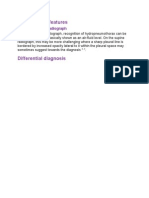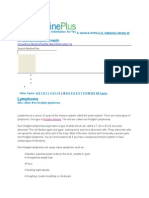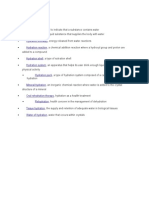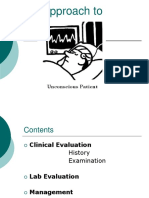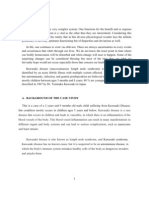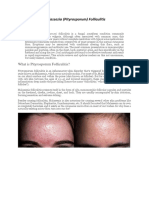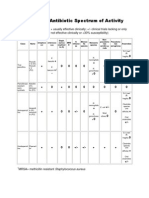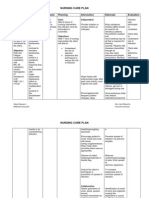Professional Documents
Culture Documents
Ancylostoma Infection
Uploaded by
navina01Original Description:
Copyright
Available Formats
Share this document
Did you find this document useful?
Is this content inappropriate?
Report this DocumentCopyright:
Available Formats
Ancylostoma Infection
Uploaded by
navina01Copyright:
Available Formats
Ancylostoma infection: Hookworm, an intestinal parasite that usually causes
diarrhea or cramps. Heavy infestation with hookworm can be serious for newborns,
children, pregnant women, and persons who are malnourished. Hookworm
infections occur mainly in tropical and subtropical climates and affect about 1
billion people -- about one-fifth of the world's population. One of the most
common species of hookworm, Ancylostoma duodenale, is found in southern
Europe, northern Africa, northern Asia, and parts of South America. A second
species, Necator americanus, was once widespread in the southeastern US early in
the 20th century.
Hookworms have a complex life cycle that begins and ends in the small intestine.
Hookworm eggs require warm, moist, shaded soil to hatch into larvae. These
barely visible larvae penetrate the skin (often through bare feet), are carried to the
lungs, go through the respiratory tract to the mouth, are swallowed, and eventually
reach the small intestine. This journey takes about a week. In the small intestine,
the larvae develop into half-inch-long worms, attach themselves to the intestinal
wall, and suck blood. The adult worms produce thousands of eggs. These eggs are
passed in the feces (stool). If the eggs contaminate soil and conditions are right,
they will hatch, molt, and develop into infective larvae again after 5 to 10 days.
Hookworm infection is contracted from contact with soil contaminated by
hookworm, by walking barefoot or accidentally swallowing contaminated soil.
Children -- because they play in dirt and often go barefoot -- are at high risk. Since
transmission of hookworm infection requires development of the larvae in soil,
hookworm cannot be spread person to person.
Chronic heavy hookworm infection can damage the growth and development of
children. The loss of iron and protein retards growth and mental development,
sometimes irreversibly. The first signs of hookworm infection are itching and a
rash at the site where the larvae penetrate the skin. These signs may be followed by
abdominal pain, diarrhea, loss of appetite and weight loss, and anemia. Hookworm
can also cause difficulty breathing, enlargement of the heart, and irregular
heartbeat. Hookworm infection have been known to be fatal, particularly in infants.
The diagnosis is by identifying hookworm eggs in a stool sample. In countries
where hookworm is common and reinfection is likely, light infections are often not
treated. In the US, hookworm infections are generally treated for 1-3 days. The
drugs are effective and appear to have few side effects. Another stool exam should
be repeated 1 to 2 weeks after therapy. If the infection is still present, treatment is
repeated. Iron supplements are in order with anemia.
People infected with hookworm are half as likely to have asthma as those without
it, in keeping with the hygiene hypothesis of asthma -- the theory that because of
better hygiene, people today tend to get fewer infections so they are at greater risk
of allergic conditions such as asthma.
To prevent hookworm, do not walk barefoot or contact the soil with bare hands in
areas where hookworm is common or there are likely to be feces in the soil or
sand.
You might also like
- Radiographic Signs of Hydropneumothorax on Chest X-RaysDocument1 pageRadiographic Signs of Hydropneumothorax on Chest X-Raysnavina01No ratings yet
- Lymphoma: Skip NavigationDocument9 pagesLymphoma: Skip Navigationnavina01No ratings yet
- HydrationDocument1 pageHydrationnavina01No ratings yet
- PDFDocument15 pagesPDFDrAmit VermaNo ratings yet
- PDF BreastDocument11 pagesPDF Breastnavina01No ratings yet
- Trauma: Clinical Practice Guidelines - TraumaDocument41 pagesTrauma: Clinical Practice Guidelines - TraumamuhamadmukhlisNo ratings yet
- Hydrate Hydrational Fluid Hydration Enthalpy Hydration ReactionDocument1 pageHydrate Hydrational Fluid Hydration Enthalpy Hydration Reactionnavina01No ratings yet
- K-6 Tubular Reabsorption and Secretion GUS-K6Document31 pagesK-6 Tubular Reabsorption and Secretion GUS-K6navina01No ratings yet
- Antibioitcs Guide 2013Document28 pagesAntibioitcs Guide 2013Taufiqurrahman Abdul DjabbarNo ratings yet
- HydrationDocument1 pageHydrationnavina01No ratings yet
- ToxoplasmosisDocument15 pagesToxoplasmosisnavina01No ratings yet
- Standard Reference IntervalsDocument1 pageStandard Reference Intervalsnavina01No ratings yet
- Hyphema r1Document2 pagesHyphema r1navina01No ratings yet
- Standard Reference IntervalsDocument1 pageStandard Reference Intervalsnavina01No ratings yet
- EM. K7c. Cardiac ArrestDocument30 pagesEM. K7c. Cardiac Arrestnavina01No ratings yet
- Ewing SarcomaDocument8 pagesEwing Sarcomanavina01No ratings yet
- Aneurysmal Bone CystDocument7 pagesAneurysmal Bone Cystnavina01No ratings yet
- Heterotrophic BacteriaDocument1 pageHeterotrophic Bacterianavina01No ratings yet
- Lampiran 4 Frequency Table: Pertanyaan 1Document4 pagesLampiran 4 Frequency Table: Pertanyaan 1navina01No ratings yet
- Ewing SarcomaDocument8 pagesEwing Sarcomanavina01No ratings yet
- Laparotomy PicDocument1 pageLaparotomy Picnavina01No ratings yet
- Action Potential: Department of Physiology School of Medicine University of Sumatera UtaraDocument15 pagesAction Potential: Department of Physiology School of Medicine University of Sumatera Utaranavina01No ratings yet
- Shoe Dog: A Memoir by the Creator of NikeFrom EverandShoe Dog: A Memoir by the Creator of NikeRating: 4.5 out of 5 stars4.5/5 (537)
- The Subtle Art of Not Giving a F*ck: A Counterintuitive Approach to Living a Good LifeFrom EverandThe Subtle Art of Not Giving a F*ck: A Counterintuitive Approach to Living a Good LifeRating: 4 out of 5 stars4/5 (5794)
- Hidden Figures: The American Dream and the Untold Story of the Black Women Mathematicians Who Helped Win the Space RaceFrom EverandHidden Figures: The American Dream and the Untold Story of the Black Women Mathematicians Who Helped Win the Space RaceRating: 4 out of 5 stars4/5 (890)
- The Yellow House: A Memoir (2019 National Book Award Winner)From EverandThe Yellow House: A Memoir (2019 National Book Award Winner)Rating: 4 out of 5 stars4/5 (98)
- The Little Book of Hygge: Danish Secrets to Happy LivingFrom EverandThe Little Book of Hygge: Danish Secrets to Happy LivingRating: 3.5 out of 5 stars3.5/5 (399)
- A Heartbreaking Work Of Staggering Genius: A Memoir Based on a True StoryFrom EverandA Heartbreaking Work Of Staggering Genius: A Memoir Based on a True StoryRating: 3.5 out of 5 stars3.5/5 (231)
- Never Split the Difference: Negotiating As If Your Life Depended On ItFrom EverandNever Split the Difference: Negotiating As If Your Life Depended On ItRating: 4.5 out of 5 stars4.5/5 (838)
- Elon Musk: Tesla, SpaceX, and the Quest for a Fantastic FutureFrom EverandElon Musk: Tesla, SpaceX, and the Quest for a Fantastic FutureRating: 4.5 out of 5 stars4.5/5 (474)
- The Hard Thing About Hard Things: Building a Business When There Are No Easy AnswersFrom EverandThe Hard Thing About Hard Things: Building a Business When There Are No Easy AnswersRating: 4.5 out of 5 stars4.5/5 (344)
- Grit: The Power of Passion and PerseveranceFrom EverandGrit: The Power of Passion and PerseveranceRating: 4 out of 5 stars4/5 (587)
- On Fire: The (Burning) Case for a Green New DealFrom EverandOn Fire: The (Burning) Case for a Green New DealRating: 4 out of 5 stars4/5 (73)
- The Emperor of All Maladies: A Biography of CancerFrom EverandThe Emperor of All Maladies: A Biography of CancerRating: 4.5 out of 5 stars4.5/5 (271)
- Devil in the Grove: Thurgood Marshall, the Groveland Boys, and the Dawn of a New AmericaFrom EverandDevil in the Grove: Thurgood Marshall, the Groveland Boys, and the Dawn of a New AmericaRating: 4.5 out of 5 stars4.5/5 (265)
- The Gifts of Imperfection: Let Go of Who You Think You're Supposed to Be and Embrace Who You AreFrom EverandThe Gifts of Imperfection: Let Go of Who You Think You're Supposed to Be and Embrace Who You AreRating: 4 out of 5 stars4/5 (1090)
- Team of Rivals: The Political Genius of Abraham LincolnFrom EverandTeam of Rivals: The Political Genius of Abraham LincolnRating: 4.5 out of 5 stars4.5/5 (234)
- The World Is Flat 3.0: A Brief History of the Twenty-first CenturyFrom EverandThe World Is Flat 3.0: A Brief History of the Twenty-first CenturyRating: 3.5 out of 5 stars3.5/5 (2219)
- The Unwinding: An Inner History of the New AmericaFrom EverandThe Unwinding: An Inner History of the New AmericaRating: 4 out of 5 stars4/5 (45)
- The Sympathizer: A Novel (Pulitzer Prize for Fiction)From EverandThe Sympathizer: A Novel (Pulitzer Prize for Fiction)Rating: 4.5 out of 5 stars4.5/5 (119)
- Her Body and Other Parties: StoriesFrom EverandHer Body and Other Parties: StoriesRating: 4 out of 5 stars4/5 (821)
- Ebola Research PaperDocument57 pagesEbola Research PaperTony Omorotionmwan Airhiavbere100% (1)
- 11-124-1-PB (1) Vanc Neph PDFDocument7 pages11-124-1-PB (1) Vanc Neph PDFTheo PentoneNo ratings yet
- Approach To An Unconscious PatientDocument62 pagesApproach To An Unconscious Patientangiolikkia80% (5)
- STD 9th Science and Technology Chapter Assessment 8 Useful and Harmful Microbes PDFDocument2 pagesSTD 9th Science and Technology Chapter Assessment 8 Useful and Harmful Microbes PDFManya JainNo ratings yet
- Tarif 2018 Rev 9 Wil 3-New (Kirim Kontraktor)Document27 pagesTarif 2018 Rev 9 Wil 3-New (Kirim Kontraktor)Aprillia PutrieNo ratings yet
- S14 - PSC Shastri Nagar (Ghaziabad) H.No: Si-10, Near Obc Bank, Shastri NagarDocument3 pagesS14 - PSC Shastri Nagar (Ghaziabad) H.No: Si-10, Near Obc Bank, Shastri NagarAnonymous TvppppNo ratings yet
- Seminar Paper.1Document38 pagesSeminar Paper.1Geckho AdeNo ratings yet
- Antimicrobials and Antibiotic Coverage GuideDocument6 pagesAntimicrobials and Antibiotic Coverage GuideGordon BongNo ratings yet
- University of Santo Tomas: UST-SHS Practical Research 2Document3 pagesUniversity of Santo Tomas: UST-SHS Practical Research 2MayNo ratings yet
- Kawasaki DiseaseDocument22 pagesKawasaki DiseaseMax LocoNo ratings yet
- Pityrosporum FolliculitisDocument3 pagesPityrosporum Folliculitisshivam18No ratings yet
- HerpanginaDocument8 pagesHerpanginaWendy Nadya Vitasani HalohoNo ratings yet
- Nursing Case Study: University of Perpetual Help System-Molino CampusDocument6 pagesNursing Case Study: University of Perpetual Help System-Molino CampusSheen AponNo ratings yet
- M265 Lec 17 - Specimen Collection Handling For The Microbiology Laboratory PDFDocument17 pagesM265 Lec 17 - Specimen Collection Handling For The Microbiology Laboratory PDFHãnëën Twalbeh100% (2)
- Fixation of Mandibular Fractures With 2.0 MM MiniplatesDocument7 pagesFixation of Mandibular Fractures With 2.0 MM MiniplatesRajan KarmakarNo ratings yet
- Beta Lactam Antibiotic Spectrum of ActivityDocument4 pagesBeta Lactam Antibiotic Spectrum of ActivityChintan ChavdaNo ratings yet
- Killer Whales (Orcas) That Died in Captivity by Date of DeathDocument6 pagesKiller Whales (Orcas) That Died in Captivity by Date of DeathThe Orca Project Corp100% (1)
- Study Consent FormDocument7 pagesStudy Consent FormMD YASIN BISWASNo ratings yet
- Students Medical Record Form Updated 12-15-23 2Document2 pagesStudents Medical Record Form Updated 12-15-23 2Kim SosaNo ratings yet
- Nursing Care PlanDocument8 pagesNursing Care PlanVincent QuitorianoNo ratings yet
- Bakteri Anaerob: Morfologi, Fisiologi, Epidemiologi, Diagnosis, Pemeriksaan Sy. Miftahul El J.TDocument46 pagesBakteri Anaerob: Morfologi, Fisiologi, Epidemiologi, Diagnosis, Pemeriksaan Sy. Miftahul El J.TADINo ratings yet
- 2.4 Filarial Worms (PG 30-38)Document38 pages2.4 Filarial Worms (PG 30-38)Rj RiveraNo ratings yet
- Clindamycin Gel Is Used ForDocument4 pagesClindamycin Gel Is Used Forgustavo83_prNo ratings yet
- PEDIADRUGDocument6 pagesPEDIADRUGPatrice LimNo ratings yet
- NCP 2 QiDocument3 pagesNCP 2 QiKarlo Tuazon SedigoNo ratings yet
- Pediatric Infectious Disease - A Practically Painless Review (2015)Document213 pagesPediatric Infectious Disease - A Practically Painless Review (2015)Fajrin Ashari100% (2)
- SANGUINARIA Polygonum AviculareDocument7 pagesSANGUINARIA Polygonum AviculareBiol. Miguel Angel Gutiérrez DomínguezNo ratings yet
- Imovax Polio Larutan Injeksi 0,5 ML (Pre-Filled Syringe)Document1 pageImovax Polio Larutan Injeksi 0,5 ML (Pre-Filled Syringe)kemalahmadNo ratings yet
- New Microsoft Office Word DocumentDocument5 pagesNew Microsoft Office Word DocumentAvinash KashyapNo ratings yet
- Dsa 1032Document166 pagesDsa 1032Shalu PurushothamanNo ratings yet
